Size Zheng
Eric
SwiftSpec: Ultra-Low Latency LLM Decoding by Scaling Asynchronous Speculative Decoding
Jun 12, 2025Abstract:Low-latency decoding for large language models (LLMs) is crucial for applications like chatbots and code assistants, yet generating long outputs remains slow in single-query settings. Prior work on speculative decoding (which combines a small draft model with a larger target model) and tensor parallelism has each accelerated decoding. However, conventional approaches fail to apply both simultaneously due to imbalanced compute requirements (between draft and target models), KV-cache inconsistencies, and communication overheads under small-batch tensor-parallelism. This paper introduces SwiftSpec, a system that targets ultra-low latency for LLM decoding. SwiftSpec redesigns the speculative decoding pipeline in an asynchronous and disaggregated manner, so that each component can be scaled flexibly and remove draft overhead from the critical path. To realize this design, SwiftSpec proposes parallel tree generation, tree-aware KV cache management, and fused, latency-optimized kernels to overcome the challenges listed above. Across 5 model families and 6 datasets, SwiftSpec achieves an average of 1.75x speedup over state-of-the-art speculative decoding systems and, as a highlight, serves Llama3-70B at 348 tokens/s on 8 Nvidia Hopper GPUs, making it the fastest known system for low-latency LLM serving at this scale.
MegaScale-MoE: Large-Scale Communication-Efficient Training of Mixture-of-Experts Models in Production
May 19, 2025Abstract:We present MegaScale-MoE, a production system tailored for the efficient training of large-scale mixture-of-experts (MoE) models. MoE emerges as a promising architecture to scale large language models (LLMs) to unprecedented sizes, thereby enhancing model performance. However, existing MoE training systems experience a degradation in training efficiency, exacerbated by the escalating scale of MoE models and the continuous evolution of hardware. Recognizing the pivotal role of efficient communication in enhancing MoE training, MegaScale-MoE customizes communication-efficient parallelism strategies for attention and FFNs in each MoE layer and adopts a holistic approach to overlap communication with computation at both inter- and intra-operator levels. Additionally, MegaScale-MoE applies communication compression with adjusted communication patterns to lower precision, further improving training efficiency. When training a 352B MoE model on 1,440 NVIDIA Hopper GPUs, MegaScale-MoE achieves a training throughput of 1.41M tokens/s, improving the efficiency by 1.88$\times$ compared to Megatron-LM. We share our operational experience in accelerating MoE training and hope that by offering our insights in system design, this work will motivate future research in MoE systems.
MxMoE: Mixed-precision Quantization for MoE with Accuracy and Performance Co-Design
May 09, 2025



Abstract:Mixture-of-Experts (MoE) models face deployment challenges due to their large parameter counts and computational demands. We explore quantization for MoE models and highlight two key insights: 1) linear blocks exhibit varying quantization sensitivity, and 2) divergent expert activation frequencies create heterogeneous computational characteristics. Based on these observations, we introduce MxMoE, a mixed-precision optimization framework for MoE models that considers both algorithmic and system perspectives. MxMoE navigates the design space defined by parameter sensitivity, expert activation dynamics, and hardware resources to derive efficient mixed-precision configurations. Additionally, MxMoE automatically generates optimized mixed-precision GroupGEMM kernels, enabling parallel execution of GEMMs with different precisions. Evaluations show that MxMoE outperforms existing methods, achieving 2.4 lower Wikitext-2 perplexity than GPTQ at 2.25-bit and delivering up to 3.4x speedup over full precision, as well as up to 29.4% speedup over uniform quantization at equivalent accuracy with 5-bit weight-activation quantization. Our code is available at https://github.com/cat538/MxMoE.
MoQa: Rethinking MoE Quantization with Multi-stage Data-model Distribution Awareness
Mar 27, 2025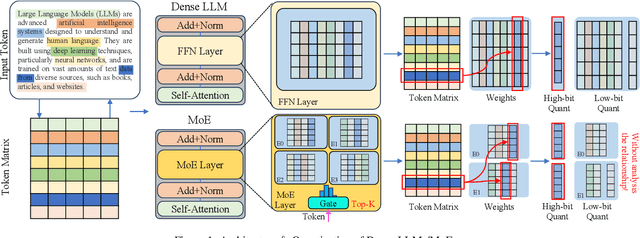
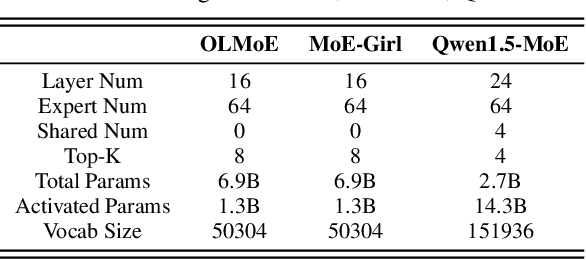
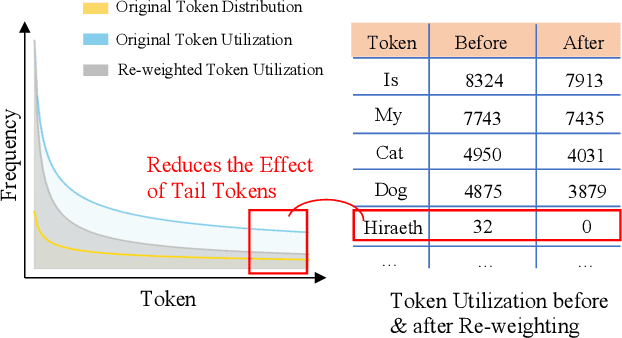
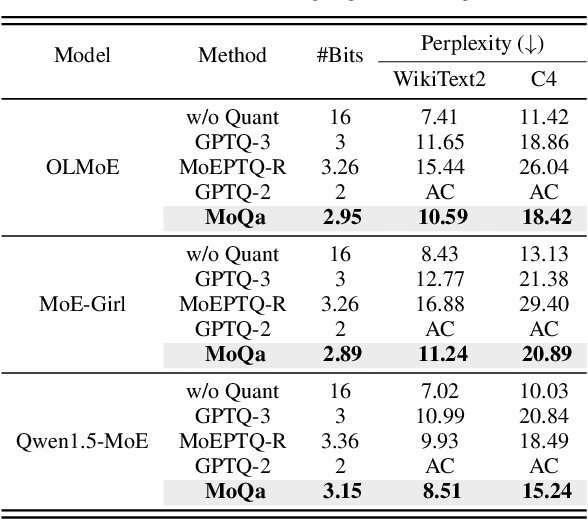
Abstract:With the advances in artificial intelligence, Mix-of-Experts (MoE) has become the main form of Large Language Models (LLMs), and its demand for model compression is increasing. Quantization is an effective method that not only compresses the models but also significantly accelerates their performance. Existing quantization methods have gradually shifted the focus from parameter scaling to the analysis of data distributions. However, their analysis is designed for dense LLMs and relies on the simple one-model-all-data mapping, which is unsuitable for MoEs. This paper proposes a new quantization framework called MoQa. MoQa decouples the data-model distribution complexity of MoEs in multiple analysis stages, quantitively revealing the dynamics during sparse data activation, data-parameter mapping, and inter-expert correlations. Based on these, MoQa identifies particular experts' and parameters' significance with optimal data-model distribution awareness and proposes a series of fine-grained mix-quantization strategies adaptive to various data activation and expert combination scenarios. Moreover, MoQa discusses the limitations of existing quantization and analyzes the impact of each stage analysis, showing novel insights for MoE quantization. Experiments show that MoQa achieves a 1.69~2.18 perplexity decrease in language modeling tasks and a 1.58%~8.91% accuracy improvement in zero-shot inference tasks. We believe MoQa will play a role in future MoE construction, optimization, and compression.
Comet: Fine-grained Computation-communication Overlapping for Mixture-of-Experts
Feb 27, 2025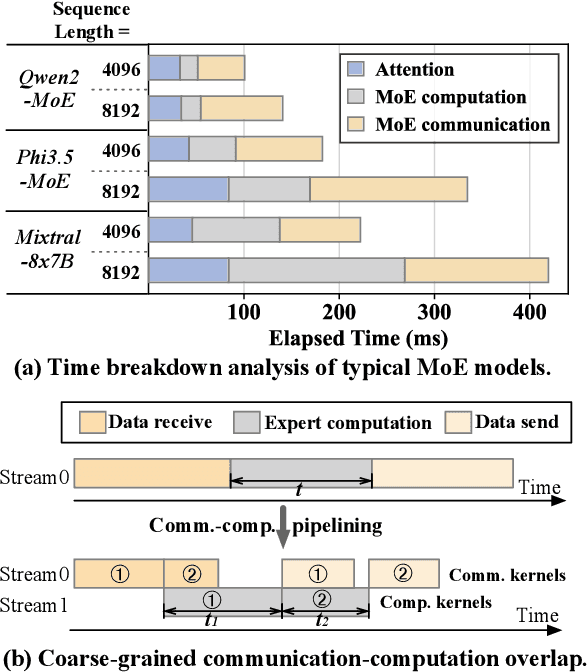



Abstract:Mixture-of-experts (MoE) has been extensively employed to scale large language models to trillion-plus parameters while maintaining a fixed computational cost. The development of large MoE models in the distributed scenario encounters the problem of large communication overhead. The inter-device communication of a MoE layer can occupy 47% time of the entire model execution with popular models and frameworks. Therefore, existing methods suggest the communication in a MoE layer to be pipelined with the computation for overlapping. However, these coarse grained overlapping schemes introduce a notable impairment of computational efficiency and the latency concealing is sub-optimal. To this end, we present COMET, an optimized MoE system with fine-grained communication-computation overlapping. Leveraging data dependency analysis and task rescheduling, COMET achieves precise fine-grained overlapping of communication and computation. Through adaptive workload assignment, COMET effectively eliminates fine-grained communication bottlenecks and enhances its adaptability across various scenarios. Our evaluation shows that COMET accelerates the execution of a single MoE layer by $1.96\times$ and for end-to-end execution, COMET delivers a $1.71\times$ speedup on average. COMET has been adopted in the production environment of clusters with ten-thousand-scale of GPUs, achieving savings of millions of GPU hours.
ShadowKV: KV Cache in Shadows for High-Throughput Long-Context LLM Inference
Oct 28, 2024Abstract:With the widespread deployment of long-context large language models (LLMs), there has been a growing demand for efficient support of high-throughput inference. However, as the key-value (KV) cache expands with the sequence length, the increasing memory footprint and the need to access it for each token generation both result in low throughput when serving long-context LLMs. While various dynamic sparse attention methods have been proposed to speed up inference while maintaining generation quality, they either fail to sufficiently reduce GPU memory consumption or introduce significant decoding latency by offloading the KV cache to the CPU. We present ShadowKV, a high-throughput long-context LLM inference system that stores the low-rank key cache and offloads the value cache to reduce the memory footprint for larger batch sizes and longer sequences. To minimize decoding latency, ShadowKV employs an accurate KV selection strategy that reconstructs minimal sparse KV pairs on-the-fly. By evaluating ShadowKV on a broad range of benchmarks, including RULER, LongBench, and Needle In A Haystack, and models like Llama-3.1-8B, Llama-3-8B-1M, GLM-4-9B-1M, Yi-9B-200K, Phi-3-Mini-128K, and Qwen2-7B-128K, we demonstrate that it can support up to 6$\times$ larger batch sizes and boost throughput by up to 3.04$\times$ on an A100 GPU without sacrificing accuracy, even surpassing the performance achievable with infinite batch size under the assumption of infinite GPU memory. The code is available at https://github.com/bytedance/ShadowKV.
Atom: Low-bit Quantization for Efficient and Accurate LLM Serving
Nov 07, 2023



Abstract:The growing demand for Large Language Models (LLMs) in applications such as content generation, intelligent chatbots, and sentiment analysis poses considerable challenges for LLM service providers. To efficiently use GPU resources and boost throughput, batching multiple requests has emerged as a popular paradigm; to further speed up batching, LLM quantization techniques reduce memory consumption and increase computing capacity. However, prevalent quantization schemes (e.g., 8-bit weight-activation quantization) cannot fully leverage the capabilities of modern GPUs, such as 4-bit integer operators, resulting in sub-optimal performance. To maximize LLMs' serving throughput, we introduce Atom, a low-bit quantization method that achieves high throughput improvements with negligible accuracy loss. Atom significantly boosts serving throughput by using low-bit operators and considerably reduces memory consumption via low-bit quantization. It attains high accuracy by applying a novel mixed-precision and fine-grained quantization process. We evaluate Atom on 4-bit weight-activation quantization setups in the serving context. Atom improves end-to-end throughput by up to $7.73\times$ compared to the FP16 and by $2.53\times$ compared to INT8 quantization, while maintaining the same latency target.
HASCO: Towards Agile HArdware and Software CO-design for Tensor Computation
May 04, 2021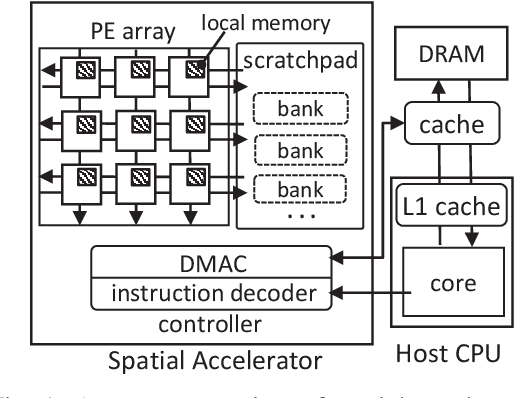

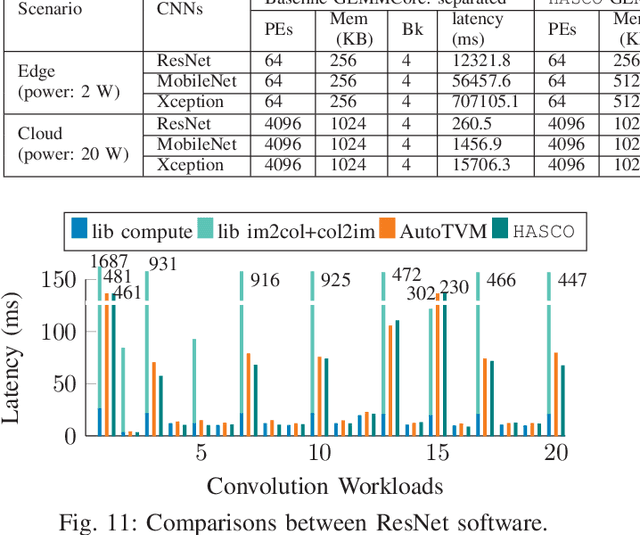
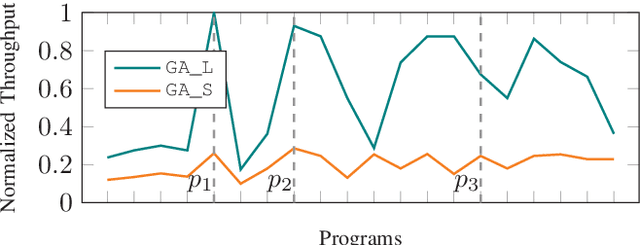
Abstract:Tensor computations overwhelm traditional general-purpose computing devices due to the large amounts of data and operations of the computations. They call for a holistic solution composed of both hardware acceleration and software mapping. Hardware/software (HW/SW) co-design optimizes the hardware and software in concert and produces high-quality solutions. There are two main challenges in the co-design flow. First, multiple methods exist to partition tensor computation and have different impacts on performance and energy efficiency. Besides, the hardware part must be implemented by the intrinsic functions of spatial accelerators. It is hard for programmers to identify and analyze the partitioning methods manually. Second, the overall design space composed of HW/SW partitioning, hardware optimization, and software optimization is huge. The design space needs to be efficiently explored. To this end, we propose an agile co-design approach HASCO that provides an efficient HW/SW solution to dense tensor computation. We use tensor syntax trees as the unified IR, based on which we develop a two-step approach to identify partitioning methods. For each method, HASCO explores the hardware and software design spaces. We propose different algorithms for the explorations, as they have distinct objectives and evaluation costs. Concretely, we develop a multi-objective Bayesian optimization algorithm to explore hardware optimization. For software optimization, we use heuristic and Q-learning algorithms. Experiments demonstrate that HASCO achieves a 1.25X to 1.44X latency reduction through HW/SW co-design compared with developing the hardware and software separately.
 Add to Chrome
Add to Chrome Add to Firefox
Add to Firefox Add to Edge
Add to Edge